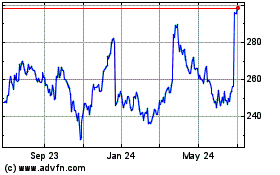FedEx Cuts Outlook Again as Unit Strains -- WSJ
March 20 2019 - 3:02AM
Dow Jones News
By Paul Ziobro
This article is being republished as part of our daily
reproduction of WSJ.com articles that also appeared in the U.S.
print edition of The Wall Street Journal (March 20, 2019).
FedEx Corp. cut its outlook for the second consecutive quarter
after it reported a decline in revenue in its express unit and
lower profit in its ground business from the higher cost of
operating six days a week.
The global delivery giant said softening macroeconomic
conditions and weaker global trade trends continue to harm its
international shipping business. Shippers also are sending lighter
packages using slower, cheaper options in the express business,
where the average price charged per package fell 2%.
FedEx Chief Executive Fred Smith said the results were below
expectations. "We are focused on initiatives to improve our
performance."
FedEx is navigating a period of turbulence in its express
air-delivery unit. It has switched CEOs at the unit twice in the
past three months and is struggling to smoothly integrate the
European delivery company TNT Express, which it bought for $4.8
billion in 2016.
The Memphis, Tenn.-based company is trying to absorb the
slowdown by reducing international capacity, limiting hiring and
cutting back on discretionary spending. It recently enacted an
voluntary buyout program for employees to save up to $275 million a
year. Chief Financial Officer Alan Graf on Tuesday said FedEx is
looking at additional actions in light of weaker-than-expected
revenue.
Meanwhile, in the U.S., FedEx's ground business posted a 6% drop
in operating income, in part due to higher costs from moving to a
six-day operating schedule year-round. Previously, FedEx would
operate six or seven days a week around the holiday season but
rising demand for shipments has pushed the company to use its
delivery network more.
Investors have been hoping that FedEx could rein in some of its
capital spending and focus on boosting margins and returning more
capital to shareholders through actions like increased stock
buybacks. But Mr. Smith defended FedEx's spending on upgrading its
aircraft fleet and adding to its shipping capacity.
"The perspective of Wall Street is always, 'Give me the money,'"
Mr. Smith said. "The perspective from inside FedEx is, 'What's the
best thing we can do for the long term?'"
For the quarter ended Feb. 28, FedEx reported a profit of $739
million, or $2.80 a share, compared with $2.07 billion, or $7.59 a
share, a year earlier, when the company benefited from a lower
deferred-tax liability due to the new tax law. Adjusted for
integration expenses and the tax benefit, per-share earnings were
$3.03 compared with $3.72 last year.
Revenue rose 3% to $17 billion. The express unit posted a 1%
revenue drop, while revenue in the ground unit rose 9%.
Analysts polled by Refinitiv most recently expected earnings of
$3.11 a share on $17.67 billion in revenue.
For the year, FedEx projected earnings of between $11.95 and
$13.10 a share, down from $12.65 to $13.40 previously.
FedEx executives continued to play down the ability of
Amazon.com Inc., which is adding more planes and trucks as well as
delivering more of its orders to homes, to disrupt the delivery
market. Chief Operating Officer Rajesh Subramaniam said] Amazon
represents only 1.3% of FedEx's revenue and isn't "a threat to our
future growth."
FedEx shares, which have dropped more than 27% over the last
year, fell an additional 4.9% in after-hours trading to $172.34.
Shares of United Parcel Service Inc. also fell 1.5% in late trading
to $108.75.
Write to Paul Ziobro at Paul.Ziobro@wsj.com
(END) Dow Jones Newswires
March 20, 2019 02:47 ET (06:47 GMT)
Copyright (c) 2019 Dow Jones & Company, Inc.
FedEx (NYSE:FDX)
Historical Stock Chart
From Mar 2024 to Apr 2024

FedEx (NYSE:FDX)
Historical Stock Chart
From Apr 2023 to Apr 2024
